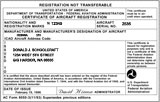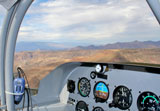|
Operation of Overweight AircraftGeneral InformationThe FAA has two primary concerns with the temporary operation of overweight aircraft: - That the public will be guarded in the event of an accident; and - That when the aircraft is returned to a standard configuration, it has not been rendered unairworthy due to the overweight operations. With safety being the primary concern, it is essential that the processing office use the technical assistance of other FAA offices or specialties as deemed necessary to ensure the highest degree of safety possible. All installations, for example, a long-range fuel system or navigational equipment, must be installed in accordance with FAA-approved data. Applications for which the proposed maximum weight does not exceed 110 percent of the maximum certificated weight, and for which the certificated CG limits are not exceeded, may be processed by district offices without obtaining an engineering evaluation (except for rotorcraft). Applications for which the proposed overweight aircraft condition exceeds 110 percent of the maximum certificated weight, or the CG limits exceed the certificated limits, must be coordinated with an ACO for an engineering evaluation of the structural integrity and for any other provisions deemed necessary. All applications for rotorcraft must be coordinated with an ACO for an engineering evaluation of the structural integrity, the flight integrity, and for any other provisions deemed necessary. The processing of an application must encompass a review of the airworthiness status of the basic aircraft, an evaluation of the added installations that constitute the excess weight, required flightcrew member qualifications, and proposed operating limitations. Technical Data for Added InstallationsWhen an application is submitted for an airplane overweight aircraft operation of more than 110% or for a rotorcraft overweight aircraft operation, any drawings and reports submitted with the application must be sufficiently detailed to show that the added installations are structurally and functionally safe. The drawings should allow for a conformity inspection of the added installations, and structural reports should reference the drawings used for the installation(s). Record of Installation(s)The installation(s) added to the aircraft for the intended overweight aircraft flight must be recorded in accordance with the requirements of FAR 43.9. The following statement must be entered in Section 3 of the FAA Form 337: “No person may operate this aircraft, as altered herein, unless it has within it an appropriate and current special flight permit issued under FAR 21.” Auxiliary Fuel System InstallationIn the evaluation of the auxiliary fuel system installations, the following items will be considered: - The aircraft and auxiliary fuel system must meet all applicable airworthiness requirements, except for those the aircraft cannot meet because of its overweight condition. The aircraft and auxiliary fuel system must be found safe for the intended flight. - Fuel tank(s) installed in a pressurized area should be tested for the maximum pressure differential existing between cabin pressurization and aircraft maximum operating altitude with fuel tank(s) empty. - Adequate ventilation must be provided for the fuel tank(s) and the area in which the fuel tank(s) are located to prevent the accumulation of fumes that would be detrimental to the flight crew or present a fire or explosion hazard. - A means must be provided to readily determine the quantity of fuel in the auxiliary tank(s) prior to takeoff. In addition, a means must be provided to indicate the quantity of fuel in tanks that have a vapor/excess fuel return line, both prior to takeoff and during flight. - The location of the fuel tank(s) in the aircraft is a major factor in determining that the aircraft is safe for flight because the added fuel and fuel facilities have the greatest effect on the aircraft’s CG. In addition, the fuel system installation must not restrict entrance to or exit from the aircraft as provided by the applicable section of 14 CFR. If required under FAR 23.1001 (amendment 23-7), the aircraft should have an adequate fuel jettison system installed. - Auxiliary fuel systems that are not complete, that is, not connected to the basic aircraft fuel system, may not be considered for issuance of a special flight permit. Engine Oil QuantityThe applicant must show that the oil supply provided for each engine is sufficient to ensure satisfactory cooling and system circulation for the duration of the overweight aircraft flight. If deemed necessary, an oil transfer system for replenishing the engine oil while the aircraft is in flight must be provided. Maximum Weight and Center of Gravity LimitsFAR 21.197(b) limits any excess weight over the certificated maximum weight to additional fuel, fuel carrying facilities, and navigational equipment added for the intended flight. It must be determined that this part of the maximum weight complies with this requirement. When numerous alterations are performed, it may be necessary to weigh the aircraft to establish the aircraft weight and the CG limits. The computations should be evaluated for accuracy. It also may be necessary to require flight testing at the new maximum weight and CG limits to determine that the aircraft is safe for operation. Computed weight and balance information should be reflected on the FAA Form 337, Section 8. Operation of rotorcraft over the certificated maximum weight presents some unique conditions over and above those encountered with fixed-wing aircraft. Special attention will be given to this type of aircraft. A careful evaluation will be made to determine what effect the overweight operation may have on the retirement times of critical parts. Operating limitations must be prescribed as deemed necessary, and will include: - Operation in the overweight condition must be conducted to avoid cities, towns, villages, and congested areas, or any other areas where the flights might create hazards to persons or property. - A certain runway (if applicable) must be used for overweight takeoff (and landing when appropriate). If an en route stop is scheduled, the following will be added: Contact FAA office, [city, routing symbol, and telephone number] for runway to be used for overweight takeoff and landing at [city]. - A copy of the FAA Form 337 covering the additional fuel-carrying facilities and equipment must be in the aircraft. - Special entries to note required inspection of the aircraft for possible damage due to overweight aircraft operation upon completion of the flight(s)
|









